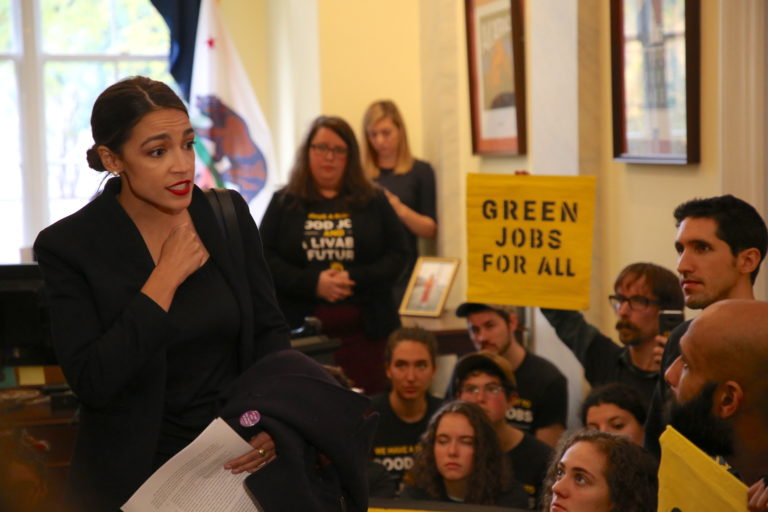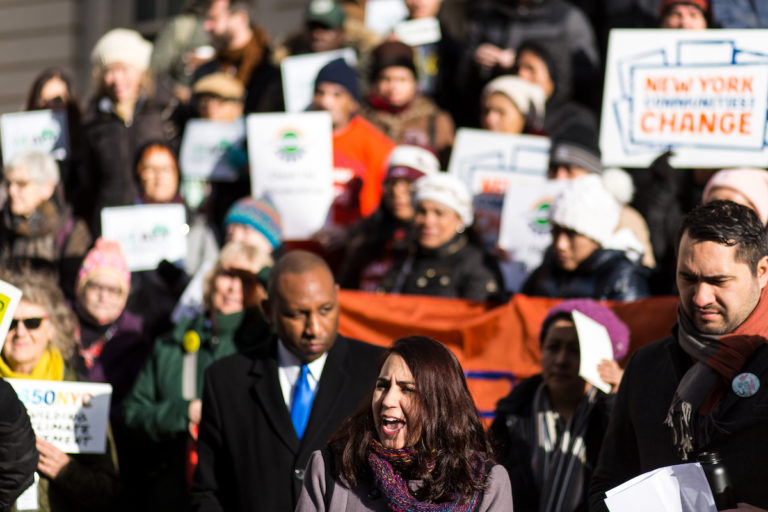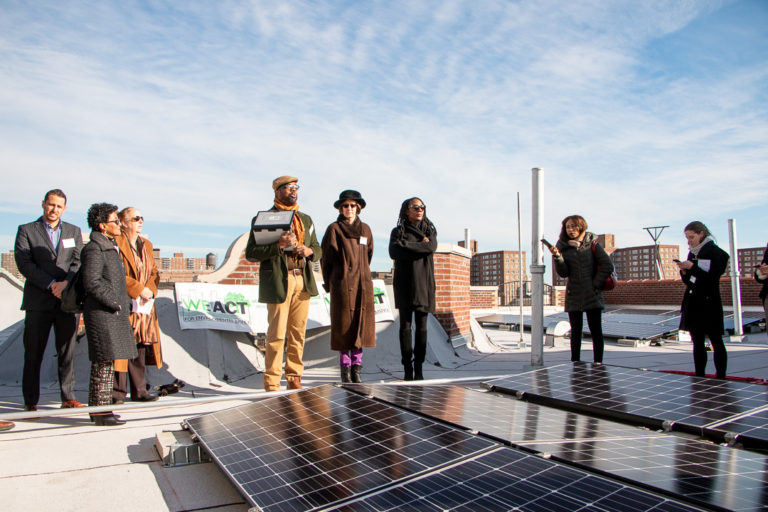Gearing Up for a Green New Deal - Alexandria Ocasio-Cortez and the plan to change everything
A thirty-foot sperm whale comes up for air. Before slipping back into the deep blue its eye gleans sight of something strange in the distance. To the whale, it looks like a flock of seagulls, each with three wings flapping. For some reason, they can’t take off.
She doesn’t pay them any mind. She’s busy with a calf to feed, her third in the past decade. When she was a calf herself, the three-winged seagulls weren’t there. But she is spotting more and more of them as she swims off the coast of Long Island these days.
She’s noticed other changes as well. The water is cleaner, and there are more and more of her kind coming upon one another. And why not? There’s plenty of squid and a lot fewer plastic bags to prey on these days.
Unbeknownst to her, the two aren’t unrelated, the fertile ocean and the strange birds on shore — what the whale’s distant evolutionary relatives in the human race refer to as wind turbines. If her eye could stray further, take on a loftier gaze, she would see that her distant cousins are busy at work, raising solar panels atop their buildings and homes, retrofitting them too, so that they will be cooler in the summer and warmer in the winter. She’d witness streets virtually devoid of vehicles save for schools of buses, gobbling up passengers like cephalopods and subway cars gliding without a hitch, graceful as eels over bridges.
This is a world where human and animal and environment are approaching harmony. It is nowhere near the “Hallelujah” chorus of Handel’s Messiah, but it has come a long way from the thrash-metal discord days of fracking, tar sands extraction, open-pit coal mining, uranium excavation, deepwater drilling, deforestation and the general masochistic flaming frenzy that characterized 20th and early 21st-century ecology. In other words, it is a far cry from the world we currently inhabit. It’s one that, if built, will be built by dreamers. It will require those in power now — who, for all their talk about the glory of capitalist innovation, can’t see beyond tomorrow’s Dow Jones index to save the planet — to listen to America’s youth, its scientists, its rebels and to the rumblings of Gaia herself and make way for some true innovation.
If this green future comes to pass, those of us fortunate enough to inhabit it may look back on Nov. 13, 2018 as a turning point. That’s the day 200 young climate change activists occupied the soon-to-be Speaker of the House’s office on Capitol Hill, many carrying orange placards that asked, “What is your plan?” Fifty-one youth in total were arrested, charged with obstruction.

Credit: Sunrise Movement.
In addition to a fine, the charge carries with it a certain irony. While they were there to disrupt business as usual in Nancy Pelosi’s lair, the underlying purpose of their visit was to make a deal, a Green New Deal, and spur the kind of investment in combating and adapting to climate change that Pelosi and other leaders of the country’s two main political parties have obstructed over the past two decades. Coming as it did in the wake of a UN Intergovernmental Panel on Climate Change (IPCC) report that warns humankind has just 12 years to drastically reduce its output of heat-trapping greenhouse gases or global warming will be irreversible, and given extra media attention thanks to the presence of camera-trailed Congresswoman-elect, Alexandria Ocasio-Cortez (D-NY), the sit-in helped push the Green New Deal into the national conversation.
‘What Science And Justice Demand’
So, what is a Green New Deal and why are our nation’s elites so reluctant to move on it?
A Green New Deal is a much-needed “overhaul of our economy that is in line with what science and justice demand,” says Stephen O’Hanlon, a spokesperson for the youth-led Sunrise Movement, the organization that, along with Justice Democrats, orchestrated the sit-in at Pelosi’s office.
What he and other Green New Deal proponents describe is essentially a public works program on the scale of or perhaps greater than New Deal 1.0 and the subsequent national economic mobilization that came with the United States’ entrance into World War II. It is a proposed massive public investment that would heal the planet, address historical injustices — racial, economic, environmental — and strengthen the economy. It “would put equity at its center so that we can stop climate change, give our generation a livable planet, create millions of good-paying jobs and tackle poverty,” says O’Hanlon.
A Green New Deal, says Elizabeth Yeampierre, executive director of the Brooklyn-based community organization UPROSE and national co-chair of the Climate Justice Alliance, must support “a just transition, the rights of workers, have the prior and informed consent of indigenous and frontline communities” and include the elimination of all greenhouse gases and co-pollutants that cause respiratory diseases like asthma.
The exact contours of New Deal 2.0 have yet to be detailed, and that’s what the November sit-in was all about. The immediate demand was for Pelosi to establish a Select Committee For A Green New Deal that would be mandated to present a comprehensive plan by March 2020 — just in time to drive the issue to the top of the Democratic Party’s agenda as it gears up for the elections later that year — when it will have the chance to gain control of both Congress and the White House. Advocates for a Select Committee say no Congressmember who has received campaign contributions from fossil fuel industries should be allowed to join it.
In a statement, Pelosi said she was “inspired” by the demonstrators and urged the Capitol Police to be gentle with them. Prior to the sit-in, however, mainline Dems showed scant political will to address global warming. Pelosi has burnished her image as an environmentalist in the past, but as her home state of California burned to a crisp this summer, she did her best to avoid mention of climate change while stumping around the country for fellow Dems.
Even after the publication of the U.N. report, Rep. Paul Tonko (D-NY) said he foresaw merely working on “ancillary pieces” of climate legislation for the time being. He’s the highest ranking Democrat on the Energy and Commerce Committee’s environment subcommittee. Meanwhile, Rep. Gerry Connolly (D-Va.) called for abandoning climate all together and focusing instead on “practical” and “opportunistic” goals. In other words, it just isn’t politically practical to save the human race from its own demise.
Following the Sunrise sit-in, Connolly signed on as one of 31 (and counting) Green New Deal endorsers in the House. In the meanwhile, adding extra urgency to developing a plan for a concerted national response to climate change, the Republicans will be drilling Mother Earth nine ways to Sunday. The apple of their icy eyes is the Arctic National Wildlife Refuge, thought to contain the largest untapped oil reserves in North America. In 2017, Congress approved drilling in the 30,000-square-mile nature preserve through a measure attached to its tax giveaway to the rich and 45-ton trucks could soon be rolling onto the tundra in the coming months looking for crude to tap.
Beyond the GOP being a wholly-owned subsidiary of the oil industry, the facts of climate change fly in the face of what the Republican Party stands for. Acknowledging climate change means conceding that the benefits of profits for some — in this case fossil fuel executives — don’t necessarily squirt down to the rest of us. That regulation is necessary. That government has a role to play in the economy. That markets can’t always meet demand where it is needed, in this instance the demand for items like electric cars rather than gas-guzzling vehicles consuming 9 million barrels of oil a day in the United States. And, for the party’s evangelical wing, a particularly hard fact to swallow: that the planet isn’t 6,000 years old and fixed in eternal permanence. Party leaders have proven willing to destroy Earth as we know it rather than budge an inch for reality. Adam Smith’s invisible hand is playing Nero’s fiddle and a touch more than Rome is on fire.
“Part of the problem is our ruling class is so rotten that they can’t even get their heads around the climate problem,” says economic theorist Doug Henwood. “You know, they have these fantasies like Peter Thiel running off to New Zealand, their bunkers and all that shit. They can’t escape it. But they just can’t think anything beyond the immediate short term. They should be. They should be mobilizing to do something about it.”
The Democrats & Climate Change
Most Democrats have taken a somewhat softer line on climate change than the GOP hardliners. They acknowledge global warming is real, yet have failed to take meaningful steps to address the apocalyptic scale of the problem.
The kind of massive state intervention in the economy that addressing climate change requires our elected officials to institute fell out of favor with the party of Franklin Roosevelt long before the Republicans rose to power. The Dems have always played seesaw between the interests of their corporate campaign donors and those of the party’s middle- and working-class base, but since the end of the Cold War and the demise of Soviet communism as a threat American global hegemony, they have more and more aligned themselves with the jealous interests of their elite backers.
Party leaders have embraced a business-friendly, neoliberal approach to climate change, just as they have just about everything else. It’s a logic that says you can’t offer Americans health coverage without giving away billions to insurers through a heavily-subsidized “marketplace.” You can’t provide relief to homeowners holding underwater mortgages without first bailing out the big banks. No social progress is possible without being mediated through the market, without someone on Wall Street making a buck.
The last time the Dems controlled the House with Pelosi at the helm, they passed cap-and-trade legislation, which would have set a threshold on the amount of greenhouse gas that could be emitted nationally and established an energy market wherein players could trade pollution permits. The measure never went up for a vote in the Senate but nonetheless is indicative of the party’s general approach to climate change. It’s all gung-ho to help the planet but has to ensure that there is money in it for it for bankers and corporations first.
The trouble with market-driven approaches to social change, and with climate change in particular, is that markets, while constantly fluctuating themselves, don’t take to change all that well at all. They are sensitive beasts, prone to myopia.
The closest thing to a large-scale state investment in climate adaptation and prevention the Democrats have mustered came in the form of President Obama’s 2009 post-bailout stimulus package. Billions in tax credits and subsidized loans were provided to green entrepreneurs. The stimulus helped the renewable energy industry scale up and become price competitive with fossil fuels. From 2009 to 2017, the cost of solar in North America fell from over $350 to $50 per megawatt hour, according to the Lazard investment bank while the cost of coal hovered around $100 per megawatt hour. But the next investment in a green economy will have to be in the trillions, not billions, and speed is of the essence.
The select committee Ocasio-Cortez wants Pelosi to establish would (deep breath) “develop a detailed national, industrial, economic mobilization plan… for the transition of the United States economy to become carbon neutral and to significantly draw down and capture greenhouse gases from the atmosphere and oceans and to promote economic and environmental justice and equality.” This tall order would crawl up the Congressional dumbwaiter and be ready for passage come January 2021.
What it would look like is tricky to say but the folks over at Data for Progress (DFP) have produced an ambitious outline that focuses on meeting emissions reduction targets based on the Paris climate agreement. The non-binding accord (that President Trump nonetheless withdrew from in 2017) aims at limiting Earth’s temperature rise to 1.5° Celsius — already a dangerously high fever for the planet. In order to avoid crossing over the climate threshold, the United States must, among other steps:
- Produce zero net emissions from buildings by 2030, zilch from energy and transportation by 2050.
- Reforest 40 million acres of public and private land by 2030.
- Expand, through sustainable farming, agricultural land use by 70 percent by 2050.
- Produce near zero manufacturing and packaging waste by 2040.
Shifting to a sustainable, zero emissions economy would generate 10 million new green-collar jobs within the first 10 years of its implementation, according to DFP. Among the provisions envisioned would be a federal jobs guarantee that would ensure that anyone who wanted a $15 per hour or more Green New Deal job would receive one. This would create a public option for jobs and provide an alternative to millions of workers currently stuck in low-wage or otherwise miserable jobs. Unsurprisingly, this measure polls well in both red and blue states.
A Glimpse Of The Future?

Credit: Leonardo March // The Indypendent
On a recent morning on the rooftop of 128 W. 138th Street, the folks over at WE ACT For Environmental Justice offered reporters a chance to see what a Green New Deal might look like. They’ve partnered with New York City, the state, nonprofit environmental educators with Solar One and energy panel installers at Grid City Electric to install photovoltaic solar cells on nine cooperatively-owned and two market-rate buildings in Harlem. Four of the installations have been completed. So far much of the work has been performed by laborers trained and hired from the neighborhood. In addition to saving the coops $1.7 million, the solar panels will keep 4,117 tons of greenhouse gas emissions from the atmosphere over their 25-year lifespan.
“Even before we get to a Green New Deal, the mayor under his OneNYC plan has called for renewable power on top of all public buildings,” said Cecil Corbin-Mark, WE ACT’s deputy director, when asked by The Indypendent how a project like this might be expanded. “We are calling on the mayor to say, ‘Let’s make this project move. Let’s make sure that the schools, the firehouses, the police , the post offices in this community have the opportunity to put solar on top of their roofs.’ That’s one way to immediately scale it up without dealing with the morass that is Washington, D.C.”
Adding extra impetus to the solarization drive is legislation that would double the city’s building emissions reduction goal to 40 percent by 2030 with a long-term goal of 80 percent by 2050. The measure could soon arrive on Bill de Blasio’s desk. City Councilmember Costa Constantinides (D-Astoria), who introduced the bill, and its supporters have described it as a “Green New Deal” for New York City and hope it will set a template for other major cities to follow.
A Tough Habit To Break
Globally, while renewable energy usage is on the rise, so too is natural gas and oil. In recent years, greenhouse outputs have either held steady or increased. According to a report released in December by the Global Carbon Project, 37.1 billion tons of heat-trapping gas will be released into the Earth’s atmosphere in 2018, the highest total ever. In the United States, emissions rose by 2.5 percent. China and India saw their emissions soar by 5 and 6 percent respectively. Essentially, humans are consuming more energy, the bulk of it coming from planet-warming sources with a slim remainder of wind and sun filling in the gaps.
Responding to the climate crisis requires putting fossil fuel companies out of business through taxes and regulations. A carbon tax, would have “to start high and keep getting higher,” says Henwood, though “it’s hard to imagine Congress” as is “passing something like that.” But a Green New Deal could absorb that displaced fossil-fuel workforce. Imagine a United States which, instead of selling weapons to countries like Saudi Arabia, exported wind turbines to the Indian subcontinent, solar panels to China. A nation that, rather than squandering $1.5 trillion on Trump’s tax cuts, $26 billion in yearly fossil fuel subsidies and trillions more on endless wars, invested in tackling a very immediate problem threatening our species and millions of others with extinction — and generated millions of jobs while doing it.
As Christian Parenti, author of Tropic of Chaos: Climate Change and the New Geography of Violence, observes, “the ruling class doesn’t come to its senses unless forced to.”
Before the institution of the original New Deal at the height of the Great Depression, the United States was experiencing 25 percent unemployment along with widespread hunger and misery across the land. As American factories and farms lay idle, the Soviet Union was experiencing full employment and expanding its influence on a global front. The prospect of global communism wasn’t just something your crazy Birchite uncle rants about but a concern that kept Congressmen and industrialists awake at night. Roosevelt needed to respond to the crisis or he risked having a revolution on his hands.
The situation is much different today. Wages are stagnant but the unemployment rate is less than 4 percent. And while that figure doesn’t include people who have given up looking for work (the rate of labor force participation is at its lowest in decades), it is a far cry from one in four adults being out a job.
Wind, solar and other companies in the green sector would benefit in a big way from a Green New Deal but most leading Fortune 500 companies have a non-stake in it. They rake in a substantial part of their revenues from their international operations. Apple, Google, Facebook, Amazon, General Motors, ExxonMobil, Coca-Cola, Starbucks — the United States may be home but it’s just one more square on the economic checkerboard. Their executives’ main concern is low corporate, capital gains and individual tax rates and hence disinvestment in the public sphere. There are also major portions of corporate America simply engaged in straight-up asset stripping — deindustrialization, public sector privatizations, debt portfolios.
Yet, with rising sea levels, extreme storms, droughts and raging fires expected to knock billions out of the U.S. economy in the decades to come, Parenti sees conditions conspiring that could compel the ruling class to act.
As a jumping-off point, “There’s a weird thing about the state and weather, disaster more specifically,” he says. “The U.S. government has since its very beginning intervened and tried to make people whole after natural disasters. As climate change continues to accelerate, the price tag for that continues to soar. The question of who pays and whether we can afford this giant military” could reach a boiling point.

Credit: Samuel McMullen // The Indypendent
This often-glossed-over history of the state stepping in doesn’t just apply to floods and fires, even in our neoliberal epoch. The government was, after all, forced to rescue the economy during the 2008 financial crash. That bailout might have looked different were it dispensed today. Given the popularity of politicians such as Bernie Sanders, Ocasio-Cortez and groups like the Democratic Socialists of America, there would be a real opportunity to call for wealth redistribution, Parenti argues.
Regardless, natural disasters have something to teach us.
“Storms are physically damaging and disruptive but they are also ideologically damaging and disruptive,” says Parenti. “The rhetoric of selfishness and market hubris, all that goes out the window. In a moment of crisis, giving people free stuff is laudable. Self-sacrifice is laudable. Solidarity is expected and laudable. If at a moment of crisis those values come to the fore, how long should they come to the fore and why only at a moment of crisis?”
As The Indypendent was going to press, the Sunrise Movement conducted another sit-in on Capitol Hill on Monday, Dec. 10. This time 143 demonstrators were arrested in a protest that included more than 1,000, mostly-young people calling on Pelosi, soon-to-be Majority Leader Steny Hoyer and Rep. Jim McGovern to support the Green New Deal committee before Congress breaks for winter.
“I want to make sure that it happens,” McGovern, the incoming Chair of the influential House Rules Committee, told the protesters. “But we have to work out the details. We shouldn’t get hung up on every little detail.”
In a tweet, Hoyer, who has received more than $250,000 from the fossil-fuel industry, said he was “happy to hear” from the Sunrise Movement and that he appreciates their “passion.”
The youth activists don’t want Congressional leaders to recognize their passion, they want them to recognize science. A full-blown climate crisis is barreling at us like a wrecking ball off its chain. We can spot it coming from a mile away. But physics and chemistry operate at one pace, politics at another. The question of whether we achieve a Green New Deal, or make any effective effort to dodge global warming’s impact at all, could depend on the size and strength of a latter-day environmental movement rising up from below.
Dean Patterson and John Tarleton contributed to this report.


Spread the word